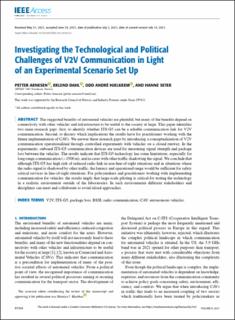| dc.contributor.author | Arnesen, Petter | |
| dc.contributor.author | Dahl, Erlend | |
| dc.contributor.author | Hjelkrem, Odd Andre | |
| dc.contributor.author | Seter, Hanne | |
| dc.date.accessioned | 2021-08-11T10:07:59Z | |
| dc.date.available | 2021-08-11T10:07:59Z | |
| dc.date.created | 2021-08-10T10:05:06Z | |
| dc.date.issued | 2021 | |
| dc.identifier.citation | IEEE Access. 2021, 9 97354-97365. | en_US |
| dc.identifier.issn | 2169-3536 | |
| dc.identifier.uri | https://hdl.handle.net/11250/2767346 | |
| dc.description.abstract | The suggested benefits of automated vehicles are plentiful, but many of the benefits depend on connectivity with other vehicles and infrastructure to be useful to the society at large. This paper identifies two main research gaps: first, to identify whether ITS-G5 can be a reliable communication link for V2V communication. Second, to discuss which implications the results have for practitioners working with the future implementation of CAVs. We answer these research gaps by introducing a conceptualization of V2V communication operationalized through controlled experiments with vehicles on a closed runway. In the experiments, onboard ITS-G5 communication devices are used for measuring signal strength and package loss between the vehicles. The results indicate that ITS-G5 technology has some limitations, especially for long range communication (>1500 m), and in cases with other traffic shadowing the signal. We conclude that although ITS-G5 has high risk of reduced radio link in non-line-of-sight situations and in situations where the radio signal is shadowed by other traffic, the latency and operational range would be sufficient for safety critical services in line-of-sight situations. For policymakers and practitioners working with implementing communication for vehicles, the results imply that large-scale piloting is critical for testing the technology in a realistic environment outside of the laboratories. In such environments different stakeholders and disciplines can meet and collaborate to avoid siloed approaches. | en_US |
| dc.language.iso | eng | en_US |
| dc.publisher | IEEE | en_US |
| dc.publisher | IEEE | |
| dc.rights | CC BY 4.0 | * |
| dc.rights.uri | https://creativecommons.org/licenses/by/4.0/ | * |
| dc.subject | V2V | en_US |
| dc.subject | ITS-G5 | en_US |
| dc.subject | Package loss | en_US |
| dc.subject | RSSI | en_US |
| dc.subject | Radio communication | en_US |
| dc.subject | CAV | en_US |
| dc.subject | Autonomous vehicles | en_US |
| dc.title | Investigating the Technological and Political Challenges of V2V Communication in Light of an Experimental Scenario Set Up | en_US |
| dc.type | Peer reviewed | en_US |
| dc.type | Journal article | en_US |
| dc.description.version | publishedVersion | en_US |
| dc.source.pagenumber | 97354-97365 | en_US |
| dc.source.volume | 9 | en_US |
| dc.source.journal | IEEE Access | en_US |
| dc.identifier.doi | 10.1109/ACCESS.2021.3094224 | |
| dc.identifier.cristin | 1924922 | |
| dc.relation.project | Norges forskningsråd: 295811. | en_US |
| cristin.ispublished | true | |
| cristin.fulltext | original | |
| cristin.qualitycode | 1 | |

